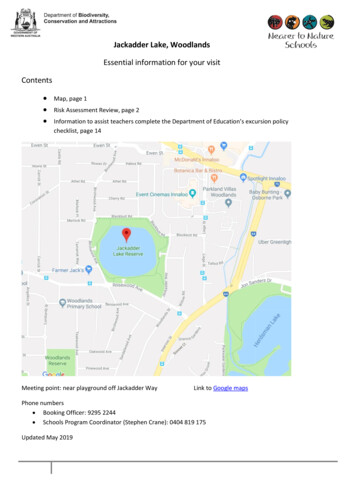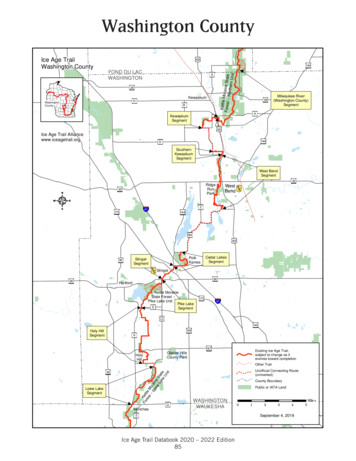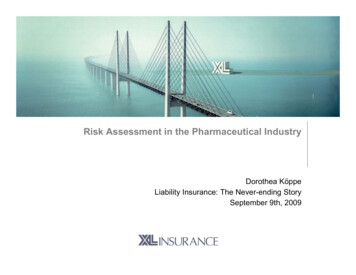
Transcription
Jackadder Lake, WoodlandsEssential information for your visitContents Map, page 1Risk Assessment Review, page 2Information to assist teachers complete the Department of Education’s excursion policychecklist, page 14Meeting point: near playground off Jackadder WayLink to Google mapsPhone numbers Booking Officer: 9295 2244 Schools Program Coordinator (Stephen Crane): 0404 819 175Updated May 2019
Jackadder Lake Risk Assessment ReviewExcursion Risk Assessment ReviewRISK MANAGEMENT ORGANISATION & KEY PERSONNELPOSITIONCONTACTCONTACT PHONE NUMBERSEducation OfficerParks and Wildlife Service,Nearer to NatureRichard Olive: 0407 981 539Bookings OfficerDepartment of Parks andWildlife, Nearer to Nature(08) 9295 2244School TeacherTBCTBCStephen Crane: 0404 819 175000 (Emergency)POLICE131 444 (Main line)9411 6400 (Scarborough Police Station)City of StirlingSecurity1300 365 356Education officer with Senior FirstAid will be onsite.FIRST AIDJoondalup HealthCampusGrand Blvd & ShentonAve, Joondalup WA6027A first aid station and kit will belocated at meeting point9400 9400POSITION RESPONSIBILITIESEducation OfficerBrief students and staff on potential risks and how to avoid them.In the event of an incident: Assume initial control of the situation with teacher Assess the situation and determine priorities Activate the relevant emergency plan Liaise with teachers Liaise with external Emergency Services Provide on-going site information for participating agencies as required Nominate relevant personnel to meet and direct emergency services Inform bookings officer of situationTeacherMonitor behavior of students to eliminate exposure to risks.In the event of an incident: Assist the Education Officer in the event of an emergency Assume control of students and other adults and direct them in the appropriate actions underthe education officers’ instructions Report situation update to the education officer as required Teacher to Liaise with school2
Jackadder Lake Risk Assessment ReviewINTRODUCTIONThis Risk Management Plan has been compiled to address the risks involved with conductingexcursions at Henderson Environmental Centre in the City of Stirling.This Risk Review examines all areas of risk associated with the general operation of excursionsand programs developed and run by Nearer to Nature at this site.This plan is to be considered as developmental and will be revised and expanded as required.AIMThe aim of this plan is to document the process whereby RISKS are: IDENTIFIEDWhat, why and how risks arise as a basis for further analysis ANALYSEDIn terms of likelihood and consequence PRIORITISEDRank risks to identify management priorities TREATEDThrough preventative and/or response measures involving:- Communication- Administrative- Structural- Training MONITOREDEstablish a system to monitor and review the performance of the process and changeswhich might affect it.OBJECTIVESThe objectives of the Risk Management Plan are to: Anticipate possible risks within the excursionProvide an effective and efficient prevention, identification and response to emergenciesSupply relevant on-site information to Emergency ServicesManage the orderly and timely evacuation if required of all attendeesEstablish and maintain a close working relationship with all relevant Emergency ServicesDevelop specific management strategies for particular types of hazardsSCOPE OF WORKJackadder Lake ExcursionThe Nearer to Nature school education program is a Department of Biodiversity, Conservationand Attractions program. Nearer to Nature run various excursions at a variety of locationsincluding at Lake Jackadder in the City of Stirling.3
Jackadder Lake Risk Assessment ReviewNearer to Nature provides the community with unique, enjoyable activities that help participantsdiscover natural areas in and around Perth and the south-west. Specially designed activitieswith curriculum links are offered for schools.Excursion held at this site are titled, ‘Aquatic Ecosystems’, ‘Wetland Connections’ and ‘WetlandsAlive’, and on the day, students will explore topics such as water quality, human impact on theecosystem, fauna surveys, and sustainability through a series of interrelated activities.Note: Jackadder Lake is a public space so close supervision of students is required at all times.RISK REVIEWRisks are evaluated on a two-dimensional matrix using a qualitative rating of the likelihood andthe scale of the possible consequence. This form of evaluation provides a good graphicalrepresentation of how serious this risk is or where the individual risk lies within a group of risks.Each risk has been rated according to the Likelihood and Consequences detailed below.LIKELIHOOD:1Almost certainThe event will occur in most circumstances2LikelyThe event will probably occur at least once3PossibleThe event might occur at some time4UnlikelyThe event is not expected to occur5RareThe event may occur only in exceptional circumstancesCONSEQUENCE (for health and safety):AInsignificantNo treatment requiredBMinorMinor injury requiring First Aid treatment (e.g. minor cuts, bruises, bumps).CModerateInjury requiring medical treatment or lost time.DMajorSerious injury requiring specialist medical treatment or hospitalisation.ESevereLoss of life, permanent disability, multiple serious injuries.4
Jackadder Lake Risk Assessment ReviewMAJOR SOURCES OF EVENT RISKThis Risk Review looks at the following major sources of operational risk; Environmental Risk – hail storms, heat. Public Health and Safety - including crowd management, pedestrian and trafficmovement, injury, assault, fire, OHS breaches. Asset Loss – theft, damage.TREATMENT OPTIONS The review outlines the treatment best suited for the risks outlined. Below is abreakdown of the options: Accept RiskAvoid RiskTransfer RiskMitigateTreat Not commercially treatable.Do not carry out the activity.Contract risk area to an expert service provider.Insure via broker, check coverage and specialized risk.Take some specialised action to reduce riskRISK IDENTIFICATIONAttached you will find the risk identification charts which outline the risks involved in variousaspects of event management. Subjects covered include: 5Human Resource ManagementNatural & Man-made disastersOperational and Crowd Safety HealthCrimes and Misdemeanours
Jackadder Lake Risk Assessment Review#Risk TypeLikelihood1 to 5ConsequenceA to EInherent Risk(low, moderate,high, extreme)Before ControlResidual Risk(low, moderate,high, extreme)After ControlNotes of TreatmentPrinciplesFireLost ChildLost AdultCriminal activity / violent /threateningCriminal activity / theftAnimal bite/attack5EHLAccept Transfer4DMAccept Risk4EELHTreat / Mitigate /TransferSlip/fallsFalling tree limbsDrowningMosquito bitesStormSyringeSunburn and DehydrationContact with unhygienic water in lake3CMLAccept Risk5EHLAccept Risk4EHMTreat/Mitigate/Transfer3CMLTreat/Accept Risk5CMLTreat / Accept Risk5EHLTreat/Accept Risk3CMLTreat/Transfer2CHMTreatHenderson Environmental Centre Excursion Day rateHigh5RareLowLowModerateModerateHigh
Jackadder Lake Risk Assessment ReviewPlease find below a list of controls and actions required for the most relevant risks associated with excursions at Neil Hawkins Park.RiskLevel of RiskControlsLevel of RiskFireH Emergency evacuation planLLost ChildH Teacher/parent supervision and responsibilityMLost AdultH Site map distributed to adultsMCriminal activity / violent /threateningH Adult supervision and responsibilityStudents informed to be aware of public and inform adultMCriminal activity / theftM Adult and student supervision and responsibility of personalbelongingsLAnimal bite/attackE First Aid PostSenior First Aid Officers onsiteStudent informed to stay away from animals where possibleSlip/fallsM First Aid PostSenior First Aid Officers onsiteSite walked to identify potential hazardsL First Aid PostSenior Aid Officers onsiteSite walked to identify trees at riskLFalling tree limbsHHDrowningH Senior First Aid Officers onsiteTeacher/parent supervision and responsibilityMMosquito bitesM Mosquito RepellantLStormM If storm occurs excursion will be cancelledLSyringeH First Aid PostSenior First Aid Officers onsiteSite walked to identify potential hazardsLSunburn and DehydrationM Sunscreen and water available onsiteSenior First Aid Officers onsiteLContact with unhygienic water in lakeH Wash hands / supply hand sanitiserMNB: N2N education officer to confirm which teacher/s has senior first aid before excursion starts. First aid to be administered by school teacher as first point, and whereappropriate with N2N education officer assisting.
Jackadder Lake Risk Assessment ReviewRISK ACTION PLANSDescriptionPrioritySummary of response and impactProposed actionsExpected level of risk after controls put inplaceDescriptionPrioritySummary of response and impactProposed actionsExpected level of risk after controls put inplaceDescriptionPrioritySummary of response and impactProposed actionsExpected level of risk after controls put inplaceDescriptionPrioritySummary of response and impactLost Child / AdultSignificantEducation Officer and teacher to raise response as appropriate After first five minutes emergency whistles blown and all adults notified. Education officer and teacher to take initial action if an incident was to occur, and then contact thePolice if required.ModerateCriminal activity / violent / threateningSignificantEducation Officer and teacher to raise response as appropriate Adults to regularly check amenities (toilet block) and patrol the area. Education officer and teachers to take initial action if an incident was to occur, and then contact thePolice if required.ModerateDeath / DrowningSignificantEducation Officer and teacher to raise response as appropriate Emergency 000 Called. Education officer and teachers to take initial action if an incident was tooccur, and then contact the Police if required.Moderate / HighSnake Bite / Animal AttackSignificantWarn students of risks; monitor student behavior. First Aid Officers to assist
Jackadder Lake Risk Assessment ReviewProposed actionsExpected level of risk after controls put inplaceDescriptionPrioritySummary of response and impactProposed actionsExpected level of risk after controls put inplace Adults and students to be aware of their surroundings and the presence of animals (in particularsnakes) at location. Education Officer and teachers to assess response ranging from monitoring patient to calling 000.Moderate / HighContact with unhygienic waterSignificantEducation officer to inform students of risks. Education officer to remind students to wash hands / use sanitiser after macroinvertebrates andwater testing.ModerateDescriptionPre-activity day safety warningSignificantPriority Teachers and parents to be advised they are responsible for their children In an emergency the education officer will blow their whistle, and everyone must meet at muster point Point out location of muster point Advise teachers of risk of child wandering off, snakes, cycles, open water. First Aid Officer and first aid station will be identified to all present
Jackadder Lake Risk Assessment ReviewEmergency Evacuation ProcedureEmergency Signal: 3 long bursts of a whistlePlease EXIT the site to car park immediatelyPlease report to the Staff member who has signalled the evacuation, they will bewearing an orange fluoro vest.
Jackadder Lake Risk Assessment ReviewInformation assisting teachers to completeDepartment of Education’s excursion policy checklistThe Department of Biodiversity, Conservation and Attractions (DBCA) Nearer to Nature Schools excursions andactivities at the Perth Hills Discovery Centre (Mundaring), the Henderson Environmental Centre (North Beach), theForest Heritage centre (Dwellingup), Canning River Eco Education Centre (Wilson), Piney Lakes EnvironmentalEducation Centre (Murdoch) and other venues meet the Department of Education’s (DoE) excursion requirements.The following information will assist teachers in completing the DoE’s Checklist for Excursion Management Plan 2003 –Appendix A for assessing the Perth Hills Discovery Centre and other excursion locations as excursion venues. Thenumbers in brackets correlate with the numbers used in the DoE’s Checklist in Appendix A.Assessing the environment (1.1)Nearer to Nature venues offer excursion activities for school groups. Activities take place both indoors and outdoors,and along tracks in the forest. Teachers can assess the centres prior to an excursion by contacting Nearer to Nature fora tour of the facilities and areas used for activities.Assessing students’ capacity (1.3)The Nearer to Nature Schools excursion activities are suitable for students of all ages. The activities have beendesigned to suit the different developmental stages of young people. Our advertising material indicates theappropriate age for each of the excursions/activities offered. There is wheelchair access to and around most venuesand limited access along some of the forest tracks.Assessing capabilities and involvement of Nearer to Nature officers (1.4 and 1.5)Nearer to Nature officers have been trained for, and have experience in, leading activities in the natural environment.They all: hold a current Working With Children Check, and are trained in first aid and hold current St John’s Senior First Aid Certificates.DBCA is a Government department and holds general liability insurance cover with a limit of 600 million through theInsurance Commission of WA (ICWA).Supervision strategies (2)Each school group is allocated a Nearer to Nature officer for the duration of the excursion. The school is required tobring the number of adult supervisors suitable for the age group of their students. Full details are provided in theconfirmation letter. On arrival at the Centre, a Nearer to Nature officer will greet the students and outline the programand the ‘housekeeping’ rules for the day. These include safety measures and defining boundaries for students.The role of a Nearer to Nature officer is to facilitate the student’s activities. School staff, however, have overall duty ofcare of their students. Teachers should inform the Nearer to Nature officer of any students with special needs ormedical conditions. Our confirmation letter requests that all students arrive for the excursion/activity with a nametag(most suitable placement is on the hat).Communication strategies (5)The school will be advised before a group departs for the excursion if the weather conditions change suddenly and areunsuitable for the excursion e.g. very strong winds, a fierce storm or very hot conditions. Our staff will arrange for analternative day. Walkie-talkies are carried by Nearer to Nature officers from the Perth Hills Discovery Centre for allactivities. Mobile telephones are carried by Nearer to Nature Officers at other venues at all times.
Jackadder Lake Risk Assessment ReviewEmergency response plan (6)The venues have an Emergency Response and Fire Evacuation plan. Our Nearer to Nature officers, in collaborationwith other delegated Departmental staff are responsible for implementing the plan. If an evacuation is required, allschool staff, students and assistants must take directions from our Nearer to Nature officers. They can be recognisedby their uniform. The Nearer to Nature administration staff have records of when and where all activities are takingplace. Student and adult numbers are recorded at the Centre prior to departure for activities in the forest.
Jackadder Lake Risk Assessment Review 5 MAJOR SOURCES OF EVENT RISK This Risk Review looks at the following major sources of operational risk; Environmental Risk - hail storms, heat. Public Health and Safety - including crowd management, pedestrian and traffic movement, injury, assault, fire, OHS breaches. Asset Loss - theft, damage.










